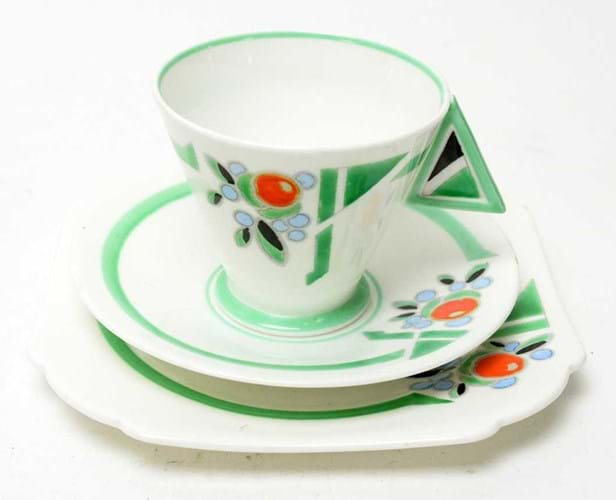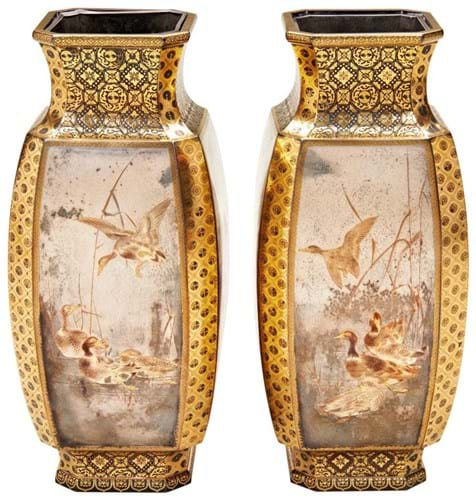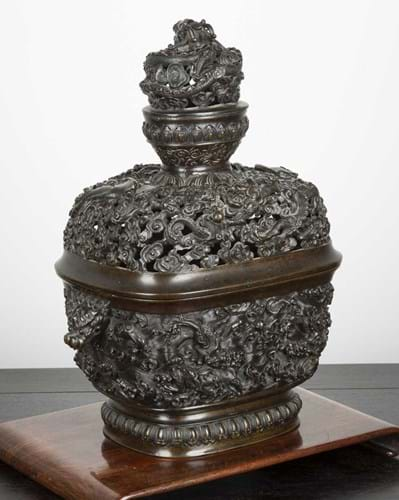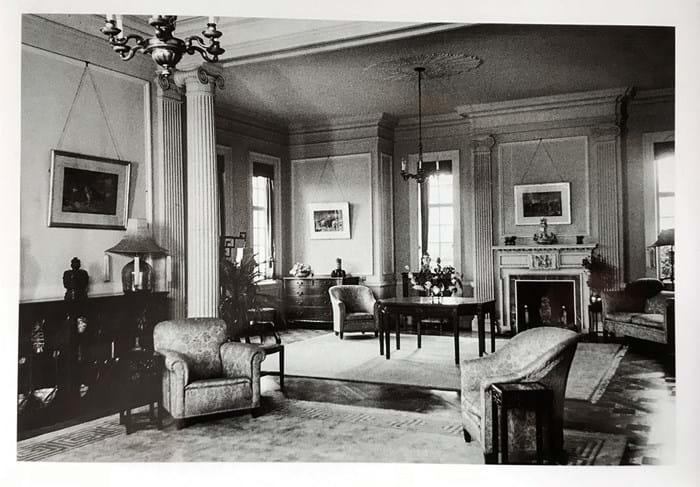1. Famous Japanese landscapes – £88,000
The Rokujuyoshu Meisho Zue (Famous Views of the Sixty-odd Provinces) series was the last great landscape work created by Japanese ukiyo-e artist Utagawa Hiroshige (1797-1858).
Pioneering the use of the vertical format, the woodblock views from each of the provinces of Japan were published in serialised form by Koshimuraya Heisuke from 1853-56.
The sale of Japanese works of art at Woolley & Wallis in Salisbury on November 15 included a near complete set of prints bound as an album c.1858. In addition to the 69 of 70 prints are, on the opening and last pages, a diptych depicting cranes in flight over crashing waves, also by Hiroshige.
It is rare that albums such as this remain intact (most were broken up in the days when the sum of its parts were greater than the whole) but those that do now command a premium. The colours in particular, protected from the ravages of light, are remarkable.
This album came for sale from an English private collection where it had been since the 1980s. Estimated at £30,000-50,000, it took £88,000.
2. Meiji damascene vases – £58,000
This pair of 9in (22cm) high Meiji damascene bronze and silver vases decorated with carp, duck, fishing boats and mountain landscape views carry the mark of Kashima Ippu (1828-1900). A master of nunomezogan in particular who exhibited at the 1890 National Industrail Exposition, a landscape plaque by him is in the collection of Tokyo National Museum.
They came for sale at Dore & Rees in Frome, Somerset on November 7 from the descendants of Joshua Neale – a partner in Neale and West, a firm of Cardiff fish merchants established in 1885. Following a friendship with a Japanese businessman, its fleet of steam trawlers were given Japanese names such as Fuji, Oku and Kyoto. During the First World War most of the vessels were taken over by the Admiralty, mainly for use as minesweepers, with seven lost to enemy action.
The pair of vases, from the top drawer of Meiji metalworking, were estimated at £25,000-35,000 and sold at £58,000.
3. Shelley tea set – £3600

A cup and saucer from the Shelley part tea set in the Truncated J or 11755 pattern – £3600 at Anderson & Garland.
Shelley first introduced the geometric Vogue and Mode shapes in 1930 – both designs by Eric Slater who had worked at the factory since the end of the First World War.
Although made for just a few years (they were not the most practical of forms), as an icon of British Art Deco, they have, in collecting terms, long been the factory’s most desirable output. From Chevron to Sunray and Blocks to Butterfly Wing, Vogue and Mode shapes were decorated with a multitude of patterns and colourways – all of them collectable – but some are more familiar than others.
The part tea set offered by Anderson & Garland as part of a Homes & Interiors sale in Newcastle upon Tyne on November 15 was recognised by collectors as the Truncated J or 11755 pattern to the Mode shape.
It was made in several colourways, including coral red, orange and blue but this was in a harder-to-find green. Comprising five cups, six saucers, six side plates, a cream jug and a sandwich plate, it was always likely to find plenty of admirers at its estimate of just £80-120. However, the hammer price was a punchy £3600.
4. Gaudier-Brzeska bronze – £26,000
This 12in (30cm) bronze cast of Henri Gaudier-Brzeska’s Crouching Fawn came for sale at Bellmans in West Sussex on November 15 with a provenance to a member of the Courtauld family. It had been a gift to her housekeeper from Jeanne Courtauld (1909-2003), daughter of John 'Jack' Courtauld (MP for Chichester 1924-42) and the niece of Samuel Courtauld, founder of The Courtauld Institute of Art in London.
Crouching Fawn was originally carved by Gaudier in 1913 in Bath stone. It formed part of the 1918 Memorial Exhibition at the Leicester Galleries that followed the artist's death in the First World War.
The original remained in the family of the original purchasers until it was sold at Christie's in 2007 for £125,000. However, it is thought the Leicester Galleries had at least 12 bronze casts made between 1918-39 before presenting the plaster cast to the Victoria & Albert Museum. This example from that run was estimated at £8000-12,000 and sold at £26,000.
5. Chinese censer – £118,000
This large reticulated 'dragon and phoenix' censer came for sale at Mallams’ Cheltenham saleroom on November 9 from a Herefordshire vendor whose family had lived in Shanghai in the 1930s.
The family house designed by Clough Williams-Ellis was known as Hazelwood – a large classical property on the site of what is today the Radisson Xingguo Hotel. Mao Tse Tung is known to have used and stayed at the property. Black and white photos in the catalogue show the censer and other bronzes in situ – something that doubtless added to their appeal.
The large dent to one side was (according to one uncorroborated family story) caused by a bullet. The bronze, weighing close to 8kg and standing 13in (33cm) high on a hardwood stand, has a six-character Ming (Xuande) mark to the base but was made in the Qianlong period. A similar but smaller censer was sold at Bonhams, New York in March 2017 for $7000.
However, bidding for this example, estimated at £1000-2000, reached £118,000 with the winning bid coming from overseas.











